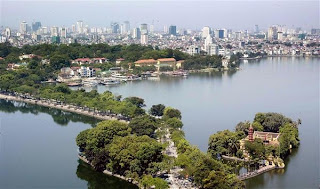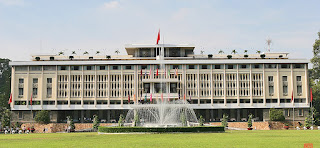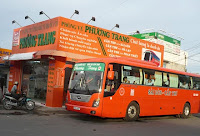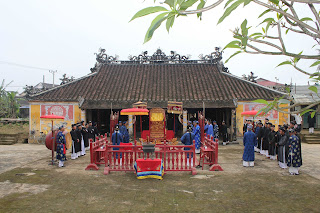Hanoi, where to go
The Old Quarter is located north of Hoan Kiem Lake of Hanoi. In the past, each street used to be dedicated to one commercial activity. That is why a lot of streets name begin with the word Hang, meaning merchandise, followed by a word indicating a product or profession. For example, Hang Dao (Peach St.) or Hang Duong (Sugar St.).
Close to Dong Xuan Market is Hang Ma (Paper St.) where traditional votive products made of colored paper are sold. Every year, on the occasion of the Mid-Autumn Festival (15th day of the 8th lunar month), Hang Ma St. turns into a toy market. Another very typical street is Hang Thiec (tin products), where the deafening sound of hammers striking tin plates can be heard all day long. During the Le Dynasty (15th century), many Chinese were allowed to reside in Thang Long. They chose to settle on Hang Ngang St. At this period, there were gates at the two ends of the street, hence the name Ngang, meaning horizontal barrier.
Below are some tourist site in the Old Quarter of Hanoi that visitors should not miss on their trip to Hanoi, Vietnam.
Close to Dong Xuan Market is Hang Ma (Paper St.) where traditional votive products made of colored paper are sold. Every year, on the occasion of the Mid-Autumn Festival (15th day of the 8th lunar month), Hang Ma St. turns into a toy market. Another very typical street is Hang Thiec (tin products), where the deafening sound of hammers striking tin plates can be heard all day long. During the Le Dynasty (15th century), many Chinese were allowed to reside in Thang Long. They chose to settle on Hang Ngang St. At this period, there were gates at the two ends of the street, hence the name Ngang, meaning horizontal barrier.
Below are some tourist site in the Old Quarter of Hanoi that visitors should not miss on their trip to Hanoi, Vietnam.
 |
| Pho Hang Ma - Paper street, Hanoi |
Dong Xuan Market
Ma May Ancient House
Among tens of markets in the capital, such as Mo, Horn, Cua Nam or Ngoc Ha, Dong Xuan is the biggest. It was founded in 1889 in the Dong Xuan Quarter. At first, it was an open- air market, but it was later rebuilt with five iron arches and a roof made of zinc-coated iron sheets.
Located near the railway station, at the beginning of Long Bien Bridge, by the Red River, Dong Xuan Market is a convenient place for goods from everywhere to converge. At this market, you can find almost any everyday goods. Dong Xuan Market is also the biggest wholesale market in the North. Today, although it has been expanded and renovated to include three large, modern and spacious floors, it has still kept its original facade architecture.
Dong Xuan Market played a historical part since it was used as a glorious defense system for the soldiers protecting Ha Noi from the French in 1946. It is open from 6am to 6pm every day.
Located near the railway station, at the beginning of Long Bien Bridge, by the Red River, Dong Xuan Market is a convenient place for goods from everywhere to converge. At this market, you can find almost any everyday goods. Dong Xuan Market is also the biggest wholesale market in the North. Today, although it has been expanded and renovated to include three large, modern and spacious floors, it has still kept its original facade architecture.
Dong Xuan Market played a historical part since it was used as a glorious defense system for the soldiers protecting Ha Noi from the French in 1946. It is open from 6am to 6pm every day.
Ma May Ancient House
Located at 87 Ma May Street, north of Hoan Kiem Lake in the Old Quarter, the delightful house is worth visiting. It is one of rare ancient house still preserved in Ha Noi.
The house was built at the end of the 19th century according to the structure of traditional house. There is a small yard between buildings to have wind and light. The ground floor (facing street) used to selling goods, and the inner used for living and producing, and at the end is kitchen and toilet. On the second floor, the room - facing street used for worshipping and receiving guests, and the inside room used for bedrooms. After restoration many times, the house still kept old architecture decorations of Ha Noi.
The house is open from Monday to Friday, from 9am to 11.30am and from 2 to 5pm.
The house was built at the end of the 19th century according to the structure of traditional house. There is a small yard between buildings to have wind and light. The ground floor (facing street) used to selling goods, and the inner used for living and producing, and at the end is kitchen and toilet. On the second floor, the room - facing street used for worshipping and receiving guests, and the inside room used for bedrooms. After restoration many times, the house still kept old architecture decorations of Ha Noi.
The house is open from Monday to Friday, from 9am to 11.30am and from 2 to 5pm.
Ha Noi Opera House
The construction of the Ha Noi Opera House was started in 1901 and completed in 1911. It was modeled on the style of Paris Opera. It is the first opera house in Ha Noi that was built on a large scale and bears the architectural styles of modern European opera houses.
The house is 87m long and 30m wide. The audience's room is about 566m² and holds more than 900 seats. The ceiling is 30m high and in typically Greek style. The second floor houses many small compartments. The first and second floor has a balcony in the front and two staircases, which are very convenient for going upstairs and downstairs. Behind the stage are working rooms, make-up rooms, the rehearsal room and the meeting hall.
It is a major performing art cent re in Ha Noi. In front of it is the August Revolution Square which is situated at the axis of Trang Tien and Hang Khay Streets. On August 17, 1945 Hanoians witnessed the national yellow- starred red flag flying on the balcony of the second floor of the Opera House. On August 19, 1945 Hanoians held a meeting in response to the call of the Viet Minh Troupe for a revolt which was later turned into an armed demonstration to seize power in Ha Noi.
With the support of the French Government in 1997, the House was refurbished to its original conditions. After nearly a century, it appears as beautiful and magnificent as it did in its early days. It can cater to stage many art forms on demand from domestic and overseas art companies.
The house is 87m long and 30m wide. The audience's room is about 566m² and holds more than 900 seats. The ceiling is 30m high and in typically Greek style. The second floor houses many small compartments. The first and second floor has a balcony in the front and two staircases, which are very convenient for going upstairs and downstairs. Behind the stage are working rooms, make-up rooms, the rehearsal room and the meeting hall.
It is a major performing art cent re in Ha Noi. In front of it is the August Revolution Square which is situated at the axis of Trang Tien and Hang Khay Streets. On August 17, 1945 Hanoians witnessed the national yellow- starred red flag flying on the balcony of the second floor of the Opera House. On August 19, 1945 Hanoians held a meeting in response to the call of the Viet Minh Troupe for a revolt which was later turned into an armed demonstration to seize power in Ha Noi.
With the support of the French Government in 1997, the House was refurbished to its original conditions. After nearly a century, it appears as beautiful and magnificent as it did in its early days. It can cater to stage many art forms on demand from domestic and overseas art companies.
Ha Noi Cathedral
Ha Noi Cathedral, also known as Saint Joseph's Cathedral, was inaugurated on Christmas Day, 1887, after two years of construction. It was built on the site of the former Bao Thien Tower, which was famous in the ancient capital of Thang Long under the Ly Dynasty (11th and 12th centuries). Its design is inspired by the architecture of the Notre-Dame Cathedral in Paris.
Ha Noi Cathedral is open daily for mass from 5am to 7am and 5pm to 7pm. The entrance gate is at 40 Nha Chung St.
Ha Noi Cathedral is open daily for mass from 5am to 7am and 5pm to 7pm. The entrance gate is at 40 Nha Chung St.
Ba Dinh Square Hanoi, where to go
Ba Dinh Square is a huge plaza composed of 240 squares of grass covering an area of 32,000m2. On the west side of the esplanade is President Ho Chi Minh's commemoration area where the Ho Chi Minh Museum and President Ho Chi Minh's Stilt House are located.
President Ho Chi Minh Relic Site in the Presidential Palace
 |
| The wooden stilt house in Hanoi |
President Ho Chi Minh Relic Site in the Presidential Palace is located in Ngoc Ha Ward, Ba Dinh District. This relic site has been considered as one of the 10 special national relics (first batch) on August 12, 2009 signed by Vietnamese Prime Minister.
Here in the site are 1,456 objects, with 759 ones on display. All relics, objects and documents are well preserved so that they remain true to their origin and the state they existed at the last days of the President Ho Chi Minh's life. Covering an area of more than 10ha, the site consists of houses, garden, lawn, fish pond, and pathways.
Opening time: all days except afternoon of Mondays and Fridays
- Summer: 7h30 to 11h and 14h to 16h
-Winter: 8hto 11hand 13h30 to 16h
Here in the site are 1,456 objects, with 759 ones on display. All relics, objects and documents are well preserved so that they remain true to their origin and the state they existed at the last days of the President Ho Chi Minh's life. Covering an area of more than 10ha, the site consists of houses, garden, lawn, fish pond, and pathways.
- The Wooden Stilt House is where President Ho Chi Minh lived and worked from mid-May 1958 to 1969. The stilt house was built from April 15 to May 17, 1958. The wooden tiled roof two-storey house overlooks a garden where scented flowers are planted. The house has a green fence of hibiscus plants, reminiscing an image of his house in Nghe An Province where he was born and grown up. Presently, more than 250 documents and objects made of various materials in the stilt house have been kept intact and well preserved to the state they were during President Ho Chi Minh's last days in life.
- Fish Pond located in the front of the stilt house covers more than 3,000m2, with the deepest point being 3m. President Ho Chi : Minh visited the pond everyday after working hours to feed fish, mainly carp.
- Orchard covering more than 65,000m2 goes I well with fish pond, and they create green-; watery picturesque scenery for the place. The botany here is diverse with 1,271 individuals from 161 species of 54 families, including 36 species of fruit trees, 59 species of shady trees, and 67 species of flowers and bonsai trees. In the orchard, there are Xoai Road -where President Ho Chi Minh did morning exercise and had a walk after working hours in the afternoon and Gian hoa Phu Chu Tich which is considered the place as a special open-air living room for President Ho Chi Minh's meetings with dear guests, both local and foreign, on nice days.
Opening time: all days except afternoon of Mondays and Fridays
- Summer: 7h30 to 11h and 14h to 16h
-Winter: 8hto 11hand 13h30 to 16h
President Ho Chi Minh's Mausoleum
After two years of construction, President Ho Chi Minh's Mausoleum was officially inaugurated on 29 August 1975. This project was the result of a close collaboration between engineers from Viet Nam and the former Soviet Union in order to keep the remains of President Ho Chi Minh, a great patriot who was later conferred the title of "World Cultural Activist" in 1990 on the occasion of his centenary birthday.
The mausoleum is divided into three floors. The first floor is a terraced stand exclusively used for grand meetings organised at Ba Dinh Square. The second floor is the centre of the mausoleum, where the .remains of the president are kept in a chamber, accessible through a series of passages and flights of marble stairs. The upper floor is the roof. The facade of the upper floor bears the inscription "President Ho Chi Minh" in dark violet, precious stone.
The mausoleum is open to the public on Tuesday, Wednesday, Thursday, Saturday and Sunday. In summer, it is open from 7.30am to 10.30 am; in winter, from 8am to 11am. The hours are extended by 30 minutes on Sundays and holidays.
The Mausoleum is usually closed from September 5 to December 10 for maintenance. Photography is not allowed inside the mausoleum. For reservation, contact the Board for Organising Homage Paying to President Ho Chi Minh at 5 Ngoc Ha St., Tel: 3825 5128.
Hanging around Hanoi Old Quarter, you will also see some museums, pagodas, temples, and lakes. Which are famous tourist destinations for visitor to Hanoi. Please find details by separate articles for them: Pagodas & temples in Hanoi, Museums of Hanoi, Lakes in Hanoi.
Hanoi, where to go



















